
Armillaria is a genus of fungi that includes the A. mellea species known as honey fungi that live on trees and woody shrubs. It includes about 10 species formerly categorized summarily as A. mellea. Armillarias are long-lived and form the largest living fungi in the world. The largest known organism covers more than 3.4 square miles (8.8 km2) in Oregon's Malheur National Forest and is estimated to be 2,500 years old. Some species of Armillaria display bioluminescence, resulting in foxfire.

Armillaria mellea, commonly known as honey fungus, is an edible basidiomycete fungus in the genus Armillaria. It is a plant pathogen and part of a cryptic species complex of closely related and morphologically similar species. It causes Armillaria root rot in many plant species and produces mushrooms around the base of trees it has infected. The symptoms of infection appear in the crowns of infected trees as discoloured foliage, reduced growth, dieback of the branches and death. The mushrooms are edible but some people may be intolerant to them. This species is capable of producing light via bioluminescence in its mycelium.

In fungi, a basidiocarp, basidiome, or basidioma (pl. basidiomata) is the sporocarp of a basidiomycete, the multicellular structure on which the spore-producing hymenium is borne. Basidiocarps are characteristic of the hymenomycetes; rusts and smuts do not produce such structures. As with other sporocarps, epigeous (above-ground) basidiocarps that are visible to the naked eye are commonly referred to as mushrooms, while hypogeous (underground) basidiocarps are usually called false truffles.
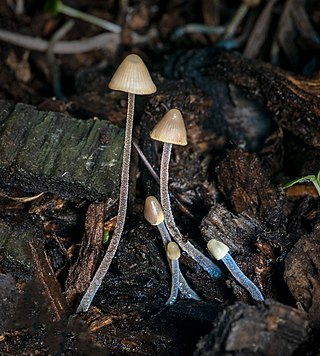
Mycena is a large genus of small saprotrophic mushrooms that are rarely more than a few centimeters in width. They are characterized by a white spore print, a small conical or bell-shaped cap, and a thin fragile stem. Most are grey or brown, but a few species have brighter colours. Most have a translucent and striate cap, which rarely has an incurved margin. The gills are attached and usually have cystidia. Some species, like Mycena haematopus, exude a latex when the stem is broken, and many species have a chlorine or radish-like odour.

Omphalotus nidiformis, or ghost fungus, is a gilled basidiomycete mushroom most notable for its bioluminescent properties. It is known to be found primarily in southern Australia and Tasmania, but was reported from India in 2012 and 2018. The fan or funnel shaped fruit bodies are up to 30 cm (12 in) across, with cream-coloured caps overlain with shades of orange, brown, purple, or bluish-black. The white or cream gills run down the length of the stipe, which is up to 8 cm (3 in) long and tapers in thickness to the base. The fungus is both saprotrophic and parasitic, and its fruit bodies are generally found growing in overlapping clusters on a wide variety of dead or dying trees.

Armillaria gallica is a species of honey mushroom in the family Physalacriaceae of the order Agaricales. The species is a common and ecologically important wood-decay fungus that can live as a saprobe, or as an opportunistic parasite in weakened tree hosts to cause root or butt rot. It is found in temperate regions of Asia, North America, and Europe. The species forms fruit bodies singly or in groups in soil or rotting wood. The fungus has been inadvertently introduced to South Africa. Armillaria gallica has had a confusing taxonomy, due in part to historical difficulties encountered in distinguishing between similar Armillaria species. The fungus received international attention in the early 1990s when an individual colony living in a Michigan forest was reported to cover an area of 15 hectares, weigh at least 9.5 tonnes, and be 1,500 years old. This individual is popularly known as the "humongous fungus", and is a tourist attraction and inspiration for an annual mushroom-themed festival in Crystal Falls. Recent studies have revised the fungus's age to 2,500 years and its size to about 400 tonnes, four times the original estimate.

Mycena haematopus, commonly known as the bleeding fairy helmet, the burgundydrop bonnet, or the bleeding Mycena, is a species of fungus in the family Mycenaceae, of the order Agaricales. It is widespread and common in Europe and North America, and has also been collected in Japan and Venezuela. It is saprotrophic—meaning that it obtains nutrients by consuming decomposing organic matter—and the fruit bodies appear in small groups or clusters on the decaying logs, trunks, and stumps of deciduous trees, particularly beech. The fungus, first described scientifically in 1799, is classified in the section Lactipedes of the genus Mycena, along with other species that produce a milky or colored latex.

Mycena polygramma, commonly known as the grooved bonnet, is a species of mushroom in the family Mycenaceae. The inedible fruit bodies are small, pale gray-brown mushrooms with broadly conical caps, pinkish gills. They are found in small troops on stumps and branches of deciduous and occasionally coniferous trees. The mushroom is found in Asia, Europe, and North America, where it is typically found on twigs or buried wood, carrying out its role in the forest ecosystem by decomposing organic matter, recycling nutrients, and forming humus in the soil. M. polygramma contains two uncommon hydroxy fatty acids and is also a bioluminescent fungus whose intensity of light emission follows a diurnal pattern.

Mycena sanguinolenta, commonly known as the bleeding bonnet, the smaller bleeding Mycena, or the terrestrial bleeding Mycena, is a species of mushroom in the family Mycenaceae. It is a common and widely distributed species, and has been found in North America, Europe, Australia, and Asia. The fungus produces reddish-brown to reddish-purple fruit bodies with conic to bell-shaped caps up to 1.5 cm (0.6 in) wide held by slender stipes up to 6 cm (2.4 in) high. When fresh, the fruit bodies will "bleed" a dark reddish-purple sap. The similar Mycena haematopus is larger, and grows on decaying wood, usually in clumps. M. sanguinolenta contains alkaloid pigments that are unique to the species, may produce an antifungal compound, and is bioluminescent. The edibility of the mushroom has not been determined.

Panellus stipticus, commonly known as the bitter oyster, the astringent panus, the luminescent panellus, or the stiptic fungus, is a species of fungus in the family Mycenaceae, and the type species of the genus Panellus. A common and widely distributed species, it is found in Asia, Australia, Europe, and North America, where it grows in groups or dense overlapping clusters on the logs, stumps, and trunks of deciduous trees, especially beech, oak, and birch. During the development of the fruit bodies, the mushrooms start out as tiny white knobs, which, over a period of one to three months, develop into fan- or kidney-shaped caps that measure up to 3 cm (1.2 in) broad. The caps are orange-yellow to brownish, and attached to the decaying wood by short stubby stalks that are connected off-center or on the side of the caps. The fungus was given its current scientific name in 1879, but has been known by many names since French mycologist Jean Bulliard first described it as Agaricus stypticus in 1783. Molecular phylogenetic analysis revealed P. stipticus to have a close genetic relationship with members of the genus Mycena.
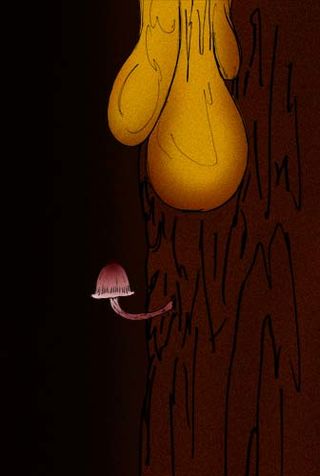
Protomycena is an extinct monotypic genus of gilled fungus in the family Mycenaceae, of order Agaricales. At present it contains the single species Protomycena electra, known from a single specimen collected in an amber mine in the Cordillera Septentrional area of the Dominican Republic. The fruit body of the fungus has a convex cap that is 5 mm (0.2 in) in diameter, with distantly spaced gills on the underside. The curved stipe is smooth and cylindrical, measuring 0.75 mm (0.030 in) thick by 10 mm (0.39 in) long, and lacks a ring. It resembles extant species of the genus Mycena. Protomycena is one of only five known agaric fungus species known in the fossil record and the second to be described from Dominican amber.
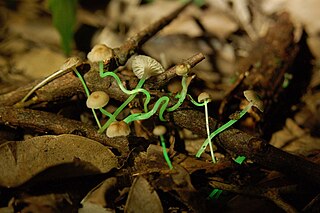
Mycena luxaeterna, commonly known as the eternal light mushroom, is a species of fungus in the family Mycenaceae. The mushrooms have parachute-shaped caps which start off darkly grayish-brown, changing to grayish-yellow or pale grayish-brown with a pale white ring at the edge when mature, and reach up to 2 cm (0.79 in) in diameter. Their thin, cylindrical, hollow, fragile stems up to 8 mm (0.31 in) in diameter are covered in a thick gel and emit a constant yellow-green bioluminescence. The gills are attached. The mushroom has a slightly radish-like smell and similar slightly bitter taste.
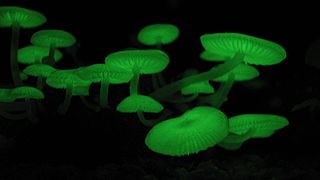
Mycena chlorophos is a species of agaric fungus in the family Mycenaceae. First described in 1860, the fungus is found in subtropical Asia, including India, Japan, Taiwan, Polynesia, Indonesia, and Sri Lanka, in Australia, and Brazil. Fruit bodies (mushrooms) have pale brownish-grey sticky caps up to 30 mm (1.2 in) in diameter atop stems 6–30 mm (0.2–1.2 in) long and up to a millimeter thick. The mushrooms are bioluminescent and emit a pale green light. Fruiting occurs in forests on fallen woody debris such as dead twigs, branches, and logs. The fungus can be made to grow and fruit in laboratory conditions, and the growth conditions affecting bioluminescence have been investigated.
Mycena asterina is a species of agaric fungus in the family Mycenaceae. It is found in São Paulo state, Brazil, where it grows singly or scattered on fallen leaves in Atlantic forests. The fruit bodies of the fungus are bioluminescent.

Mycena tintinnabulum is a European species of agaric fungus in the family Mycenaceae. The mycelium, but not the fruit body, is bioluminescent.
Mycena daisyogunensis is a species of agaric fungus in the family Mycenaceae. The fruit bodies of the fungus are bioluminescent. It was collected from Daisyogun Cave in Miyazaki Prefecture on Kyushu, Japan.
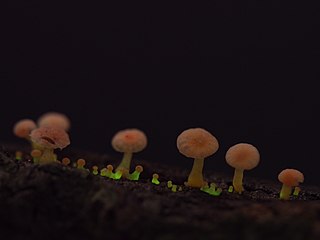
Mycena roseoflava is a species of agaric mushroom in the family Mycenaceae. It was first discovered in 1964 by New Zealand mycologist Greta Stevenson. It is a wood-inhabiting mushroom native to New Zealand.
Mycena indigotica is a species of fungus. It was described for the first time in 2018 by Chia Ling Wei and Roland Kirschner after its discovery on the North-western Pacific Island of Taiwan. The genus Mycena is most famous for containing the majority of described bioluminescent fungi. However, M. indigotica is one of the many non-bioluminescent species within the genus. Nonetheless, this mushroom is aesthetically striking, with a petite and novel morphology.
Filoboletus hanedae, is a species of agaric fungus in the family Mycenaceae native to South-East Asia, first described by George S. Kobayashi. Its fruiting bodies display bioluminescence.
















